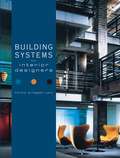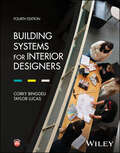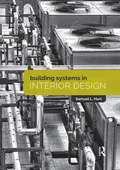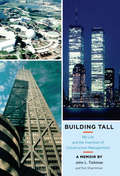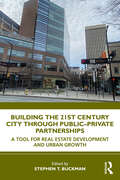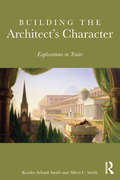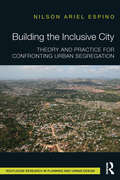- Table View
- List View
Building Systems for Interior Designers
by Corky BinggeliThe first desk reference on technical building systems for interior designers Building Systems for Interior Designers is the first book to explain technical building systems and engineering issues in a clear and accessible way to interior designers. The technical knowledge and vocabulary presented here allow interior designers to communicate more effectively with architects, engineers, and contractors while collaborating on projects, leading to more accurate solutions for problems related to a broad range of other building considerations with an impact on interior design. Information on sustainable design is integrated throughout the book, making it a relevant tool for current and emerging trends in building design. Written in a straightforward, nontechnical style that maintains depth and accuracy, this book is the first complete text applicable to interior design courses and provides thorough preparation for the NCIDQ exam. Engaging, clear illustrations support the text, which is accessible to those without a math or physics background. Topics covered include: Heating and air conditioning systems Environmental issues Water and waste Thermal comfort HVAC systems Electricity Lighting Security and communications systems Fire safety Transportation systems With numerous case examples illustrating how interior designers apply this material in the real world, Building Systems for Interior Designers is a valuable book for students, as well as a practical desktop reference for professionals. Content from this book is available as an online continuing professional education course at http://www.wiley.com/WileyCDA/Section/id-320255.html#fire_safety. WileyCPE courses are available on demand, 24 hours a day, and are approved by the American Institute of Architects.
Building Systems for Interior Designers
by Corky Binggeli Taylor LucasBUILDING SYSTEMS FOR INTERIOR DESIGNERS Make design decisions informed by technical and structural knowledge with this essential guide Professional interior design demands more than simply an understanding of aesthetic and artistic considerations; it also requires a detailed understanding of building systems and their interactions. Design decisions must account for mechanical and electrical equipment, building components, and structural elements, all of which can potentially shape a designer’s work. Building Systems for Interior Designers has long stood as the key to understanding and evaluating these elements, particularly key building systems like HVAC and plumbing, and their impacts on interior design. This Fourth Edition is fully updated to fit the needs of the CIDA certified interior design program and the NCIDQ exam. The fourth edition of Building Systems for Interior Designers also includes: Updated information on sustainable and energy-efficient design Detailed coverage of topics including security concerns, fire safety, and designing secure spaces Classroom supplements including sample construction documents, chapter specific discussion questions, and more Building Systems for Interior Designers is ideal for students in interior design courses and new professionals studying for NCIDQ exams.
Building Systems for Interior Designers
by Corky Binggeli Taylor LucasBUILDING SYSTEMS FOR INTERIOR DESIGNERS Make design decisions informed by technical and structural knowledge with this essential guide Professional interior design demands more than simply an understanding of aesthetic and artistic considerations; it also requires a detailed understanding of building systems and their interactions. Design decisions must account for mechanical and electrical equipment, building components, and structural elements, all of which can potentially shape a designer’s work. Building Systems for Interior Designers has long stood as the key to understanding and evaluating these elements, particularly key building systems like HVAC and plumbing, and their impacts on interior design. This Fourth Edition is fully updated to fit the needs of the CIDA certified interior design program and the NCIDQ exam. The fourth edition of Building Systems for Interior Designers also includes: Updated information on sustainable and energy-efficient design Detailed coverage of topics including security concerns, fire safety, and designing secure spaces Classroom supplements including sample construction documents, chapter specific discussion questions, and more Building Systems for Interior Designers is ideal for students in interior design courses and new professionals studying for NCIDQ exams.
Building Systems in Interior Design
by Sam HurtBuilding Systems in Interior Design takes an entirely new approach to teaching this essential topic for Architects, Designers and Building Engineers. Written to prepare students for the real world and packed with practical examples, the book will foster an understanding of specific issues that are critical to those features of technical systems that most directly affect design. The book stresses the ever-present nature of these systems: they are everywhere, all the time. Taking a design oriented view, it outlines what can and cannot be done, and provides the student with the know-how and confidence to defend and promote their design intent when working with other industry professionals. Covering lighting, HVAC, plumbing and much more, the book is packed with key features to aid learning including: Numerous illustrations, plans and photographs Key terms defined in an extensive glossary Chapter introductions that identify key concepts and chapter summaries to re-visit those key concepts Professional design tips And a detailed bibliography and web links This book is not only a core text for interior design, building systems engineering and architecture students but will become an essential working reference through their careers.
Building Systems in Interior Design
by Sam HurtBuilding Systems in Interior Design takes an entirely new approach to teaching this essential topic for Architects, Designers and Building Engineers. Written to prepare students for the real world and packed with practical examples, the book will foster an understanding of specific issues that are critical to those features of technical systems that most directly affect design. The book stresses the ever-present nature of these systems: they are everywhere, all the time. Taking a design oriented view, it outlines what can and cannot be done, and provides the student with the know-how and confidence to defend and promote their design intent when working with other industry professionals. Covering lighting, HVAC, plumbing and much more, the book is packed with key features to aid learning including: Numerous illustrations, plans and photographs Key terms defined in an extensive glossary Chapter introductions that identify key concepts and chapter summaries to re-visit those key concepts Professional design tips And a detailed bibliography and web links This book is not only a core text for interior design, building systems engineering and architecture students but will become an essential working reference through their careers.
Building Tall: My Life and the Invention of Construction Management
by John L Tishman Tom Shachtman"John Tishman is a true pioneer in the Construction Management industry. Through his CM leadership, some of America's most well-known buildings have been brought to successful completion." ---Bruce D'Agostino, president and chief executive, Construction Management Association of America "Building Tall will provide readers with insights into John Tishman's career as a visionary engineer, landmark builder, and great businessman. Responsible for some of the construction world's most magnificent projects, John is one of the preeminent alumni in the history of Michigan Engineering. His perspectives have helped me throughout my time as dean, and his impact will influence generations of Construction Management professionals and students." ---David C. Munson, Jr., Robert J. Vlasic Dean of Engineering, University of Michigan In this memoir, University of Michigan graduate John L. Tishman recounts the experiences and rationale that led him to create the entirely new profession now recognized and practiced as Construction Management. It evolved from his work as the construction lead of the "owner/builder" firm Tishman Realty and Construction, and his personal role as hands-on Construction Manager in the building of an astonishing array of what were at the time the world's tallest and most complex projects. These include The world's first three 100-story towers---the original "twin towers" of the World Trade Center in Manhattan and the Hancock Tower in Chicago. The Epcot Center at Disney World. The Renaissance Center in Detroit. New York's Madison Square Garden. Tishman interweaves the stories behind the construction of these and many other important buildings and projects with personal reminiscences of his dealings with Henry Ford, Jr., Disney's Michael Eisner, casino magnate Steve Wynn, and many others into a practical history of the field of Construction Management, which he pioneered. This book will be of interest not only to a general public interested in the stories and personalities behind many of the most iconic construction projects of the post–World War II period in the United States but to students of engineering and architecture and members of the new field of Construction Management.
Building Technology and Culture in the Asia-Pacific Region: Construction, Materials, Encounters (Transnational Histories of Design Cultures and Production)
by Giaime Botti Eugenio Mangi Hiroyuki ShinoharaThis book compiles a curated selection of texts authored by architects and scholars hailing from Asia, Europe, and North America. Their research, often intertwined with practical applications, delves into the intricate relationship between material culture, technology, and architecture within the broader cultural and social milieu. Three keywords—construction, materials, encounters—serve as the organizing framework for the book, guiding readers through a diverse array of case studies and experiences where these elements intertwine seamlessly. Indeed, these terms are intricately interwoven, reflecting the inseparability of technology from culture.The first part of the book delves into the poetics and theoretical underpinnings of construction, drawing from the works of various designers across China, Japan, and India. The subsequent section navigates the terrain of construction materials, exploring their evolution, manufacturing processes, and utilization, with a particular focus on diverse timber products and bamboo. The final part of this compilation embarks on a journey through historical encounters between the East and West spanning over a century. It meticulously investigates the exchanges, misunderstandings, and innovations catalyzed by these interactions. Collectively, these texts offer a profound and original perspective on the myriad experiences and challenges associated with the intricate interplay between technological advancements, tectonic preferences, and socio-cultural dynamics within the architectural landscape of the Asia-Pacific region.
Building the 21st Century City through Public-Private Partnerships: A Tool for Real Estate Development and Urban Growth
by Stephen T. BuckmanBuilding the 21st Century City through Public-Private Partnerships introduces students and early-career professionals to the fundamentals of this unique form of cross-sector collaboration. From understanding the responsibilities of government and industry partners to stewardship of taxpayer dollars, this introductory guide empowers developers and local officials to deliver successful commercial, leisure, and industrial projects neither could undertake on their own. Chapters on securing financing and navigating permitting processes demystify the steps to creating profitable developments, while case studies from around the United States provide invaluable local context. A glossary of public–private partnership terminology offers the reader an insider’s grasp of the language of government and industry partnerships. Equips developers and local officials with the foundations for successful collaboration Provides a template for building effective public–private partnerships in every area of real estate development Includes field-tested insights from case studies of diverse public–private partnership examples Ideal reading for courses in public administration, city planning, real estate, not-for-profit studies, public service, and more Helmed by a practitioner turned academic, Building the 21st Century City through Public–Private Partnerships serves as a masterclass with veteran developers, planners, municipal officials, and scholars.
Building the 21st Century City through Public-Private Partnerships: A Tool for Real Estate Development and Urban Growth
Building the 21st Century City through Public-Private Partnerships introduces students and early-career professionals to the fundamentals of this unique form of cross-sector collaboration. From understanding the responsibilities of government and industry partners to stewardship of taxpayer dollars, this introductory guide empowers developers and local officials to deliver successful commercial, leisure, and industrial projects neither could undertake on their own. Chapters on securing financing and navigating permitting processes demystify the steps to creating profitable developments, while case studies from around the United States provide invaluable local context. A glossary of public–private partnership terminology offers the reader an insider’s grasp of the language of government and industry partnerships. Equips developers and local officials with the foundations for successful collaboration Provides a template for building effective public–private partnerships in every area of real estate development Includes field-tested insights from case studies of diverse public–private partnership examples Ideal reading for courses in public administration, city planning, real estate, not-for-profit studies, public service, and more Helmed by a practitioner turned academic, Building the 21st Century City through Public–Private Partnerships serves as a masterclass with veteran developers, planners, municipal officials, and scholars.
Building the Architect's Character: Explorations in Traits
by Kendra Schank Smith Albert C. SmithAn understanding of architects’ character traits can offer important insights into how they design buildings. These traits include leadership skills necessary to coordinate a team, honest and ethical behavior, being well educated and possessing a life-long love of learning, flexibility, resourcefulness, and visionary and strategic thinking. Characteristics such as these describe a successful person. Architects also possess these traits, but they have additional skills specifically valuable for the profession. These will include the ability to question the use of digital media, new materials, processes, and methods to convey meaning in architectural form. Although not exhaustive, a discussion of such subjects as defining, imaging, persuading, and fabricating will reveal representational meaning useful for the development of an understanding of architects’ character. Through the analogies and metaphors found in Greek myth, the book describes the elusive, hard-to-define characteristics of architects to engage the dilemmas of a changing architectural landscape. Building the Architect’s Character: Explorations in Traits examines traditional and archetypal characteristics of the successful architect to ask if they remain relevant today.
Building the Architect's Character: Explorations in Traits
by Kendra Schank Smith Albert C. SmithAn understanding of architects’ character traits can offer important insights into how they design buildings. These traits include leadership skills necessary to coordinate a team, honest and ethical behavior, being well educated and possessing a life-long love of learning, flexibility, resourcefulness, and visionary and strategic thinking. Characteristics such as these describe a successful person. Architects also possess these traits, but they have additional skills specifically valuable for the profession. These will include the ability to question the use of digital media, new materials, processes, and methods to convey meaning in architectural form. Although not exhaustive, a discussion of such subjects as defining, imaging, persuading, and fabricating will reveal representational meaning useful for the development of an understanding of architects’ character. Through the analogies and metaphors found in Greek myth, the book describes the elusive, hard-to-define characteristics of architects to engage the dilemmas of a changing architectural landscape. Building the Architect’s Character: Explorations in Traits examines traditional and archetypal characteristics of the successful architect to ask if they remain relevant today.
Building the Classical World: Bauforschung as a Contemporary Approach
by Dorian Borbonus Elisha Ann DumserThis multiauthor volume presents thirteen case studies that showcase the scientific, analytical, and often archaeological study of historic buildings that is known in German as Bauforschung. Written by established and emerging experts in this field, the chapters focus on the architecture of the Classical world and cover a wide variety of topics, such as construction processes, design principles, building traditions, and historical contexts. Despite this diversity, there is a common thread, since all contributors perceive architecture not as piles of dead matter, or as mere bearers of decoration and sculpture, but as dynamic organisms--bodies full of inner tension to defy gravity. Thus, they pursue the common goal to situate architecture in its historical contexts by documenting, reconstructing, and visualizing the structures as well as their spatial settings, technical underpinnings, and ideological symbolism. Throughout this volume, ancient buildings are considered historic documents in their own right, reflecting both the efforts of their designers and builders, as well as the aspirations of their patrons and communities. The collection represents a wide cross-section of approaches brought to bear on ancient Greek and Roman architecture and, thus, serves as an English-language introduction to the technical and historical questions, and the methodologies inherent in Bauforschung.
Building the Classical World: Bauforschung as a Contemporary Approach
by Elisha Ann Dumser Dorian BorbonusThis multiauthor volume presents thirteen case studies that showcase the scientific, analytical, and often archaeological study of historic buildings that is known in German as Bauforschung. Written by established and emerging experts in this field, the chapters focus on the architecture of the Classical world and cover a wide variety of topics, such as construction processes, design principles, building traditions, and historical contexts. Despite this diversity, there is a common thread, since all contributors perceive architecture not as piles of dead matter, or as mere bearers of decoration and sculpture, but as dynamic organisms--bodies full of inner tension to defy gravity. Thus, they pursue the common goal to situate architecture in its historical contexts by documenting, reconstructing, and visualizing the structures as well as their spatial settings, technical underpinnings, and ideological symbolism. Throughout this volume, ancient buildings are considered historic documents in their own right, reflecting both the efforts of their designers and builders, as well as the aspirations of their patrons and communities. The collection represents a wide cross-section of approaches brought to bear on ancient Greek and Roman architecture and, thus, serves as an English-language introduction to the technical and historical questions, and the methodologies inherent in Bauforschung.
Building the Cycling City: The Dutch Blueprint for Urban Vitality
by Melissa Bruntlett Chris BruntlettIn car-clogged urban areas across the world, the humble bicycle is enjoying a second life as a legitimate form of transportation. City officials are rediscovering it as a multi-pronged (or -spoked) solution to acute, 21st-century problems, including affordability, obesity, congestion, climate change, inequity, and social isolation. As the world’s foremost cycling nation, the Netherlands is the only country where the number of bikes exceeds the number of people, primarily because the Dutch have built a cycling culture accessible to everyone, regardless of age, ability, or economic means.Chris and Melissa Bruntlett share the incredible success of the Netherlands through engaging interviews with local experts and stories of their own delightful experiences riding in five Dutch cities. Building the Cycling City examines the triumphs and challenges of the Dutch while also presenting stories of North American cities already implementing lessons from across the Atlantic. Discover how Dutch cities inspired Atlanta to look at its transit-bike connection in a new way and showed Seattle how to teach its residents to realize the freedom of biking, along with other encouraging examples.Tellingly, the Dutch have two words for people who ride bikes: wielrenner (“wheel runner”) and fietser (“cyclist”), the latter making up the vast majority of people pedaling on their streets, and representing a far more accessible, casual, and inclusive style of urban cycling—walking with wheels. Outside of their borders, a significant cultural shift is needed to seamlessly integrate the bicycle into everyday life and create a whole world of fietsers. The Dutch blueprint focuses on how people in a particular place want to move.The relatable success stories will leave readers inspired and ready to adopt and implement approaches to make their own cities better places to live, work, play, and—of course—cycle.
Building the French empire, 1600–1800: Colonialism and material culture (Studies in Imperialism #191)
by Benjamin SteinerThis study explores the shared history of the French empire from the perspective of material culture in order to re-evaluate the participation of colonial, Creole, and indigenous agency in the construction of imperial spaces. The decentred approach to a global history of the French colonial realm allows a new understanding of power relations in different locales. Providing case studies from four parts of the French empire, the book draws on illustrative evidence from the French archives in Aix-en-Provence and Paris as well as local archives in each colonial location. The case studies, in the Caribbean, Canada, Africa, and India, each examine building projects to show the mixed group of planners, experts, and workers, the composite nature of building materials, and elements of different ‘glocal’ styles that give the empire its concrete manifestation.
Building the French empire, 1600–1800: Colonialism and material culture (Studies in Imperialism #191)
by Benjamin SteinerThis study explores the shared history of the French empire from the perspective of material culture in order to re-evaluate the participation of colonial, Creole, and indigenous agency in the construction of imperial spaces. The decentred approach to a global history of the French colonial realm allows a new understanding of power relations in different locales. Providing case studies from four parts of the French empire, the book draws on illustrative evidence from the French archives in Aix-en-Provence and Paris as well as local archives in each colonial location. The case studies, in the Caribbean, Canada, Africa, and India, each examine building projects to show the mixed group of planners, experts, and workers, the composite nature of building materials, and elements of different ‘glocal’ styles that give the empire its concrete manifestation.
Building the Inclusive City: Theory and Practice for Confronting Urban Segregation
by Nilson Ariel EspinoUrban segregation is one of the main challenges facing urban development around the globe. The usual outcome of many urban development patterns is an unequal social geography, with the urban poor living in large clusters that are remote, isolated, dangerous or unhealthy. The result is inequality in a number of dimensions of urban life, from deficient urban access, services or infrastructure to social isolation, neighbourhood violence, and lack of economic opportunity. This book brings together debates on ethnic and economic segregation, combining theory and practical solutions to create a guide for those trying to understand and address urban segregation in any part of the world, and integrate ameliorating policies to contemporary urban development agendas.
Building the Inclusive City: Theory and Practice for Confronting Urban Segregation
by Nilson Ariel EspinoUrban segregation is one of the main challenges facing urban development around the globe. The usual outcome of many urban development patterns is an unequal social geography, with the urban poor living in large clusters that are remote, isolated, dangerous or unhealthy. The result is inequality in a number of dimensions of urban life, from deficient urban access, services or infrastructure to social isolation, neighbourhood violence, and lack of economic opportunity. This book brings together debates on ethnic and economic segregation, combining theory and practical solutions to create a guide for those trying to understand and address urban segregation in any part of the world, and integrate ameliorating policies to contemporary urban development agendas.
Building the Modern Church: Roman Catholic Church Architecture in Britain, 1955 to 1975 (Ashgate Studies in Architecture)
by Robert ProctorFifty years after the Second Vatican Council, architectural historian Robert Proctor examines the transformations in British Roman Catholic church architecture that took place in the two decades surrounding this crucial event. Inspired by new thinking in theology and changing practices of worship, and by a growing acceptance of modern art and architecture, architects designed radical new forms of church building in a campaign of new buildings for new urban contexts. A focussed study of mid-twentieth century church architecture, Building the Modern Church considers how architects and clergy constructed the image and reality of the Church as an institution through its buildings. The author examines changing conceptions of tradition and modernity, and the development of a modern church architecture that drew from the ideas of the liturgical movement. The role of Catholic clergy as patrons of modern architecture and art and the changing attitudes of the Church and its architects to modernity are examined, explaining how different strands of post-war architecture were adopted in the field of ecclesiastical buildings. The church building’s social role in defining communities through rituals and symbols is also considered, together with the relationships between churches and modernist urban planning in new towns and suburbs. Case studies analysed in detail include significant buildings and architects that have remained little known until now. Based on meticulous historical research in primary sources, theoretically informed, fully referenced, and thoroughly illustrated, this book will be of interest to anyone concerned with the church architecture, art and theology of this period.
Building the Modern Church: Roman Catholic Church Architecture in Britain, 1955 to 1975 (Ashgate Studies in Architecture)
by Robert ProctorFifty years after the Second Vatican Council, architectural historian Robert Proctor examines the transformations in British Roman Catholic church architecture that took place in the two decades surrounding this crucial event. Inspired by new thinking in theology and changing practices of worship, and by a growing acceptance of modern art and architecture, architects designed radical new forms of church building in a campaign of new buildings for new urban contexts. A focussed study of mid-twentieth century church architecture, Building the Modern Church considers how architects and clergy constructed the image and reality of the Church as an institution through its buildings. The author examines changing conceptions of tradition and modernity, and the development of a modern church architecture that drew from the ideas of the liturgical movement. The role of Catholic clergy as patrons of modern architecture and art and the changing attitudes of the Church and its architects to modernity are examined, explaining how different strands of post-war architecture were adopted in the field of ecclesiastical buildings. The church building’s social role in defining communities through rituals and symbols is also considered, together with the relationships between churches and modernist urban planning in new towns and suburbs. Case studies analysed in detail include significant buildings and architects that have remained little known until now. Based on meticulous historical research in primary sources, theoretically informed, fully referenced, and thoroughly illustrated, this book will be of interest to anyone concerned with the church architecture, art and theology of this period.
Building the post-war world: modern architecture and reconstruction in Britain (PDF)
by Nicholas BullockBuilding the Post-war World examines the way in which World War II and the ten years of reconstruction that followed saw the establishment of modern architecture in Britain. It charts the opportunities created by post-war rebuilding showing how the spirit of innovation and experimentation necessary to winning the war found applications in reconstruction. Above all it shows how hopes for a new and better world became linked to the fortunes of new architecture.
Building Theories: Architecture as the Art of Building
by Franca TrubianoBuilding Theories speaks to the value of words in architecture. It addresses the author’s fascination with the voices of architects, engineers, builders, and craftspeople whose ideas about building have been captured in text. It discusses the content of treatises, essays, articles, and letters by those who have been, throughout history, committed to the art of building. In this, Building Theories argues for the return of a practice of architectural theory that is set amongst building, buildings, and builders. This journey of close reading reinterprets the words of Vitruvius, Alberti, de L’Orme, Le Camus de Mézières, Boullée, Laugier, Rondelet, Semper, Viollet-le-Duc, Hübsch, Bötticher, Berlage, Muthesius, Wagner, Behrendt, Gropius, and Arup. With chapters dedicated to texts from antiquity, the Renaissance, and the nineteenth century, and with a critical eye on architectural theory popularized in the Anglo-Saxon world post-1968, readers are introduced to a wider, more inclusive definition of architectural ideas. Building Theories considers how contemporary scholarship has steered away from the topic of building in its reluctance to admit that both design and construction are central to its concerns. In response, it argues for a realignment of architecture with the concept of techné, with a dual commitment to fabrica e ratio, with a productive return to l’art de bien bastir, with the accurate translation of the term Baukunst, and with an appeal to the architect’s ‘composite mind.’ Students, practitioners, and educators will identify in Building Theories ways of thinking that strive for the integration of design with construction; reject the supposed primacy of the former over the latter; recognize how aesthetics are an insufficient scaffold for subtending the subject of architectural ethics; and accept, without reservation, that material transformations have always been at the origins of built form.
Building Theories: Architecture as the Art of Building
by Franca TrubianoBuilding Theories speaks to the value of words in architecture. It addresses the author’s fascination with the voices of architects, engineers, builders, and craftspeople whose ideas about building have been captured in text. It discusses the content of treatises, essays, articles, and letters by those who have been, throughout history, committed to the art of building. In this, Building Theories argues for the return of a practice of architectural theory that is set amongst building, buildings, and builders. This journey of close reading reinterprets the words of Vitruvius, Alberti, de L’Orme, Le Camus de Mézières, Boullée, Laugier, Rondelet, Semper, Viollet-le-Duc, Hübsch, Bötticher, Berlage, Muthesius, Wagner, Behrendt, Gropius, and Arup. With chapters dedicated to texts from antiquity, the Renaissance, and the nineteenth century, and with a critical eye on architectural theory popularized in the Anglo-Saxon world post-1968, readers are introduced to a wider, more inclusive definition of architectural ideas. Building Theories considers how contemporary scholarship has steered away from the topic of building in its reluctance to admit that both design and construction are central to its concerns. In response, it argues for a realignment of architecture with the concept of techné, with a dual commitment to fabrica e ratio, with a productive return to l’art de bien bastir, with the accurate translation of the term Baukunst, and with an appeal to the architect’s ‘composite mind.’ Students, practitioners, and educators will identify in Building Theories ways of thinking that strive for the integration of design with construction; reject the supposed primacy of the former over the latter; recognize how aesthetics are an insufficient scaffold for subtending the subject of architectural ethics; and accept, without reservation, that material transformations have always been at the origins of built form.
Building Time: Architecture, event, and experience
by David LeatherbarrowWhile most books on architecture concentrate on spatial themes, this book explores architecture's temporal dimensions. Through a series of close readings of buildings, both contemporary and classic, it demonstrates the centrality of time in modern architecture, and shows why an understanding of time is critical to understanding good architecture.All buildings exist in time. Even if designed for permanence, they change, slowly but inevitably. They change use, they accrue history and meaning, they decay – all of these processes are inscribed in time. So too is the path traced by the sun through a building, and the movements of the human body from room to room. Time, this book argues, is the framework for our spatial experience of architecture, and a key dimension of a building's structure and significance. Building Time presents twelve close readings of buildings and artworks which explore this idea. Examining works by distinctive modern architects – from Eileen Gray to Álvaro Siza and Wang Shu – it takes the reader, in some cases literally step-by-step, through a built work, and provides insightful reflections on the importance of 'making space for time' in architectural design.This is a book for both theorists and for architectural designers. Through it, theorists will find a way to rethink the fundamental premises and aims of design work, while designers will rediscover the order and ideas that shape the world around them-its buildings, interiors, and landscapes.
Building Time: Architecture, event, and experience
by David LeatherbarrowWhile most books on architecture concentrate on spatial themes, this book explores architecture's temporal dimensions. Through a series of close readings of buildings, both contemporary and classic, it demonstrates the centrality of time in modern architecture, and shows why an understanding of time is critical to understanding good architecture.All buildings exist in time. Even if designed for permanence, they change, slowly but inevitably. They change use, they accrue history and meaning, they decay – all of these processes are inscribed in time. So too is the path traced by the sun through a building, and the movements of the human body from room to room. Time, this book argues, is the framework for our spatial experience of architecture, and a key dimension of a building's structure and significance. Building Time presents twelve close readings of buildings and artworks which explore this idea. Examining works by distinctive modern architects – from Eileen Gray to Álvaro Siza and Wang Shu – it takes the reader, in some cases literally step-by-step, through a built work, and provides insightful reflections on the importance of 'making space for time' in architectural design.This is a book for both theorists and for architectural designers. Through it, theorists will find a way to rethink the fundamental premises and aims of design work, while designers will rediscover the order and ideas that shape the world around them-its buildings, interiors, and landscapes.
